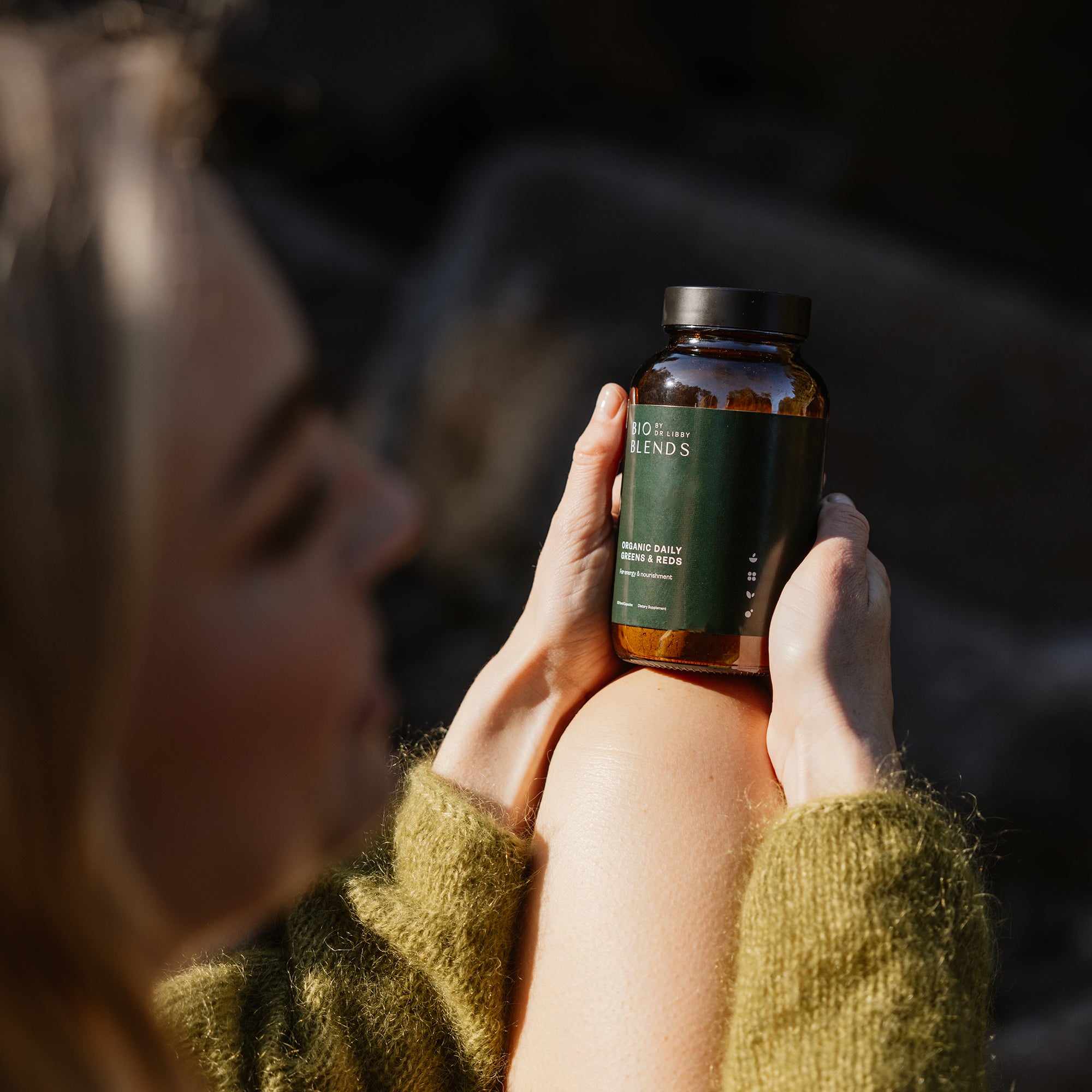How much iron do you really need? A guide for every life stage
If you’ve ever taken an iron supplement and still felt tired… Or been told your levels are “fine” but you don’t feel fine – It might come down to one simple thing:
The form of iron you’re consuming.
Because here’s the thing:
Too many supplements use iron forms that aren’t easily absorbed. Some rely on vitamin C to help. Others are blocked by tannins (hello, tea and coffee) or inadequate stomach acid. And many cause unwanted side effects – like nausea, constipation or gut irritation – making them hard to take consistently.
Form matters.
There are three main forms of iron found in food and supplements:
1. Haem iron (in the ferrous form)
Found in animal sources like red meat, organ meats, mussels and sardines. This form is readily absorbed by the body, but its uptake relies on adequate stomach acid, something too easily disrupted by persistent stress hormone production.
2. Small non-haem iron (in the ferric form)
Found in plant foods like lentils, seaweed and leafy greens. It’s less bioavailable and depends on vitamin C (or other acids) to be absorbed effectively. Because it’s present in the ferric form and iron absorption inhibitors tend to be present in these foods as well, you need to consume more to meet your needs.
3. Large non-haem iron (in the form of ferritin iron)
A relatively newly discovered plant food-sourced form of iron from organic peas and other legumes. Ferritin iron is naturally encased in a protein “cage” (that’s the ferritin part) that protects the iron as it passes through the digestive tract, allowing it to bypass the stomach and be absorbed directly at the gut wall — slowly and steadily, for optimal utilisation. The usual disruptors to iron absorption are bypassed with this form making it highly bioavailable.
In short?
Ferritin iron is one of the most bioavailable and gut-friendly forms of iron available. While small amounts are found in organic peas, it must be concentrated into a supplement to deliver a meaningful impact on your iron levels.
Want to know how much iron you really need each day – and why so many people aren’t getting enough?
Iron is one of the most essential minerals for the human body, yet it's also one of the most commonly overlooked. It plays a critical role in oxygen transport (and almost every cell inside you needs oxygen), the energy you experience, your immune function, hormone synthesis (an extra shout-out to thyroid hormones and their complete dependence on iron for production) and even brain development. But here's the thing: your iron needs change depending on your age, life stage and lifestyle. In this guide, we'll walk you through how much iron is typically required at each phase of life and why some people need more than others. The amounts quoted are the recommended dietary intake (RDI) for iron, which is what’s required to prevent deficiency. A little more may be required to recover from deficiency.
Newborns and infants
While full-term babies are born with iron stores from their mothers, these stores start to decline by around 4-6 months of age. This is why iron becomes an essential nutrient to introduce when your baby starts solids in infancy.
- Iron needs: 0.27 mg/day (0-6 months), 11 mg/day (7-12 months)
- Why it matters: Iron supports rapid growth and brain development, crucial for learning, during this critical window.
Children aged 1-3
As toddlers grow rapidly, their iron needs remain high.
- Iron needs: 7 mg/day
- Common challenges: Fussy eating and limited food variety can make it harder to get enough iron from diet alone. Iron deficiency can also contribute to fussy eating, creating a cycle that’s hard to break without intervention.
Children aged 4-8
- Iron needs: 10 mg/day
- Why it matters: At this age, children are active and constantly learning – iron helps fuel their growing bodies and developing brains. Without enough, they may experience fatigue, reduced concentration, irritability and a weakened immune system.
Children aged 9-13
- Iron needs: 8 mg/day
- Note: Needs are steady during this phase, but begin to increase as puberty begins.
Teenage boys (14-18 years)
- Iron needs: 11 mg/day
- Why it matters: Increased muscle mass and overall growth raise iron requirements and iron deficiency at this stage negatively impacts testosterone production.
Teenage girls (14-18 years)
- Iron needs: 15 mg/day however in Dr Libby’s clinical experience, this tends to be too low for optimal health (anxiety and hair loss prevention, as well as healthy periods) once menstruation has begun. The adult female RDI of 18 mg/day tends to be more suitable particularly if periods are heavy.
- Why it matters: Menstruation begins, creating iron loss that needs to be replenished monthly.
Menstruation years (including perimenopause while you are still menstruating)
- Iron needs: 18 mg/day (standard)
- Why it matters: Monthly blood loss combined with increased demands in perimenopause means women are particularly vulnerable to low iron, which puts us at risk of thyroid underactivity, among many other challenges. Needs may increase from the RDI if there is flooding or if menstruation is occurring more than once a month.
Pregnancy
Iron needs skyrocket in pregnancy due to increased blood volume and the developing baby.
- Iron needs: 27 mg/day
- Why it matters: Low iron during pregnancy is linked to complications like low birth weight, preterm birth and maternal fatigue. It’s also essential for building the baby’s own iron stores – which help sustain them through the first 4–6 months of life.
Postnatally
After giving birth, women may be depleted from pregnancy and birth blood loss.
- Iron needs: 9-10 mg/day (lactating), though higher supplementation may be needed based on blood test results, depending on where levels landed at the end of the pregnancy.
- Tip: Postnatal fatigue and the emotional lability some women experience at this stage can sometimes be iron deficiency in disguise.
Adult males
- Iron needs: 8 mg/day
- Note: While men need less iron than women, athletes, frequent blood donors or those with digestive issues may still be at risk.
Athletes (or those who train like athletes)
- Iron needs: Endurance athletes, particularly mid-to-long distance runners, may need to obtain 70% more iron per day than the RDI for their gender and life stage.
- Tip: Supplementation is often necessary, particularly for menstruating female athletes who would likely struggle to obtain the 30.6 mg per day they require from food alone.
Post-menopausal women
- Iron needs: 8 mg/day
- Why it matters: After menstruation ends, iron needs drop. However, long-standing deficiencies or malabsorption may still require attention. This is, however, a stage to watch for the genetic iron storage disorder called haemochromatosis to emerge and if found, iron supplementation must be avoided.
Vegetarian or vegan eaters
- Iron needs: 1.8 times the RDI for your age/stage
- For example, this places the iron requirements for a menstruating female who eats this way at 32.4 mg/day
- This is due to the poorer absorption of the small non-haem iron found in plant foods as well as the likely presence of more iron absorption inhibitors in this way of eating.
Please note that these figures are general guidelines, and individual needs may vary. If you're experiencing symptoms like fatigue, brain fog, low mood, a racing heart, anxiety, hair loss, low thyroid hormone production or the symptoms of an underactive thyroid, or poor exercise recovery, it's worth investigating your iron status with your healthcare professional.
And remember: it's not just how much iron you're consuming, but how well you're absorbing it that matters.



